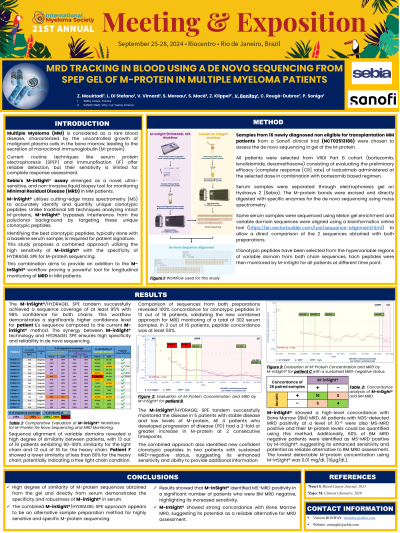MRD and Biomarkers
MRD tracking in blood using a de novo sequencing from SPEP gel of M-protein in Multiple Myeloma Patients
P-180: MRD tracking in blood using a de novo sequencing from SPEP gel of M-protein in Multiple Myeloma Patients
Thursday, September 26, 2024


Zarouki MOUKTADI (he/him/his)
MSc
SEBIA
Evry-Courcouronnes, Ile-de-France, France
Introduction: Multiple Myeloma (MM) is considered as a rare blood disease, characterized by the uncontrolled growth of malignant plasma cells in the bone marrow, leading to the secretion of monoclonal immunoglobulin (M-protein). Current routine techniques like serum protein electrophoresis (SPEP) and immunofixation (IF) offer reliable detection, but their sensitivity is limited for complete response assessment. Sebia's M-inSight assay emerged as a novel, ultra-sensitive, and non-invasive liquid biopsy tool for monitoring Minimal Residual Disease (MRD) in MM patients. M-inSight utilizes cutting-edge mass spectrometry (MS) to accurately identify and quantify unique clonotypic peptides. Unlike traditional MS techniques analyzing intact M-proteins, M-inSight bypasses interference from the polyclonal background by targeting these unique clonotypic peptides. Identifying the best clonotypic peptides, typically done with a baseline serum sample, is required for patient signature. This study proposes a combined approach utilizing the high sensitivity of M-inSight with the specificity of HYDRAGEL SPE for M-protein sequencing. This combination aims to provide an addition to the M-inSight workflow proving a powerful tool for longitudinal monitoring of MRD in MM patients.
Methods: Samples from 15 newly diagnosed non eligible for transplantation MM patients from a Sanofi clinical trial (NCT02513186) were chosen to assess the de novo sequencing in gel of the M-protein. All patients were selected from VRDI Part B cohort (bortezomib, lenalidomide, dexamethasone) consisting of evaluating the preliminary efficacy (complete response [CR] rate) of isatuximab administered at the selected dose in combination with bortezomib based regimen.
Serum samples were separated through electrophoresis gel on Hydrasys 2 (Sebia). The M-protein bands were excised and directly digested with specific enzymes for the de novo sequencing using mass spectrometry. Same serum samples were sequenced using Melon gel enrichment to allow a direct comparison of the 2 sequences obtained with both preparations.
Results: Sequences were obtained for the light and heavy chains using both preparations. Each M-protein sequence had a coverage of at least 95% with a confidence of 98%. The sequences obtained with both techniques showed a similarity ranging from 90 to 100%. Identical clonotypic peptides were found for all patients when comparing both methods, allowing a quantitative monitoring of a total of 302 serum samples. M-insight was able to monitor the disease on 5 patients who had a stable disease with a low level of M-protein. All 4 patients that developed PD had an increase of M-protein of at least 2-fold at 2 consecutive timepoints. The lowest M-protein concentration level measured by M-InSight was 0.01 mg/dL.
Conclusions: Identical M-protein sequenced from the gel and directly from serum demonstrates the specificity and robustness of M-inSight in serum. The separation in gel allows an alternative sample preparation for M-protein sequencing.
Methods: Samples from 15 newly diagnosed non eligible for transplantation MM patients from a Sanofi clinical trial (NCT02513186) were chosen to assess the de novo sequencing in gel of the M-protein. All patients were selected from VRDI Part B cohort (bortezomib, lenalidomide, dexamethasone) consisting of evaluating the preliminary efficacy (complete response [CR] rate) of isatuximab administered at the selected dose in combination with bortezomib based regimen.
Serum samples were separated through electrophoresis gel on Hydrasys 2 (Sebia). The M-protein bands were excised and directly digested with specific enzymes for the de novo sequencing using mass spectrometry. Same serum samples were sequenced using Melon gel enrichment to allow a direct comparison of the 2 sequences obtained with both preparations.
Results: Sequences were obtained for the light and heavy chains using both preparations. Each M-protein sequence had a coverage of at least 95% with a confidence of 98%. The sequences obtained with both techniques showed a similarity ranging from 90 to 100%. Identical clonotypic peptides were found for all patients when comparing both methods, allowing a quantitative monitoring of a total of 302 serum samples. M-insight was able to monitor the disease on 5 patients who had a stable disease with a low level of M-protein. All 4 patients that developed PD had an increase of M-protein of at least 2-fold at 2 consecutive timepoints. The lowest M-protein concentration level measured by M-InSight was 0.01 mg/dL.
Conclusions: Identical M-protein sequenced from the gel and directly from serum demonstrates the specificity and robustness of M-inSight in serum. The separation in gel allows an alternative sample preparation for M-protein sequencing.